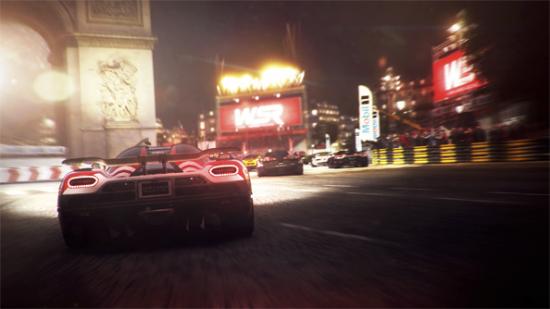The engineer in Grid 2 sounds a lot like Scott Bakula out of 80s bodyswapping science-fiction TV show Quantum Leap. Coupled with the sensation that my mind has been spontaneously dumped into the skull of a car racing YouTube celebrity, that I have no idea what my name is, where all these cars have come from or why I’m driving them around in circles, Grid 2 really feels like a lost episode of Quantum Leap. I’m fairly certain it’s set in the same universe at least, and that I’m driving around the world, getting into street races and putting right what once went wrong. Ziggy says that if I take pole position there is a 97% chance I will leap.
But this isn’t Quantum Leap. Grid 2 is a game about racing cars from Codemasters, a studio renowned for making excellent games about racing cars. It feels almost redundant to point out that the handling very much feels like it’s been designed by a team who’ve spent an awful lot of time thinking about how cars should look, sound and feel. Every car in Grid 2 handles differently, though they all share the same sense of weighty heft and snappy traction. As to be expected, they’re less slippy than the rally cars of Dirt 2, the last racing game I obsessed over, but they share the same inclination to go sideways around corners during street races and drift events, screaming and belching thick plumes of tyre smoke as they go. Grid 2 has really nice, volumetric white smoke. You can get lost in the stuff.
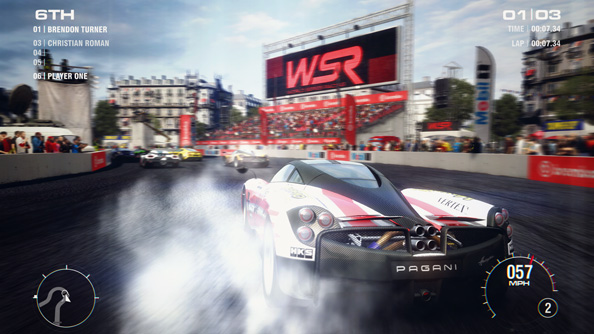
On flatter track races, in faster supercars, the game’s personality changes with its handling. Here, your Paganis and your Koenigseggs feel flighty and featherlight at slow speeds, only sticking to the road once you open up the throttle and let the car’s aerodynamically engineered shape push it into the tarmac using physics and downforces and science. Grid 2’s supercars are really grumpy when you ask them to go slow, throwing tantrums and spinning out like big metal babies. The handling throughout falls somewhere between driving simulation and arcade racing, though it’s just nuanced enough to feel believable and challenging, and developed enough to be able to become skilled at.
AI drivers retain the eerie fallibility that made Grid famous. They’ll spin out ahead of you, find themselves jolted off the racing line by a mistimed brake, aggressively block your passing and take dangerous risks on last corners. On one occasion, during a drift event in which bigger skids mean more points, I saw a competitor halfway up a hillside having artificially intelligenced himself into a tree. On the regular difficulty setting the game will dial down their abilities, and give you a slightly faster car, to ensure your advantage. On higher difficulties, AI drivers become devious bastards – rarely destructive, but certainly uncompromising when it comes to sharing the road. Familiarity with tracks, and knowing where to overtake, becomes essential.
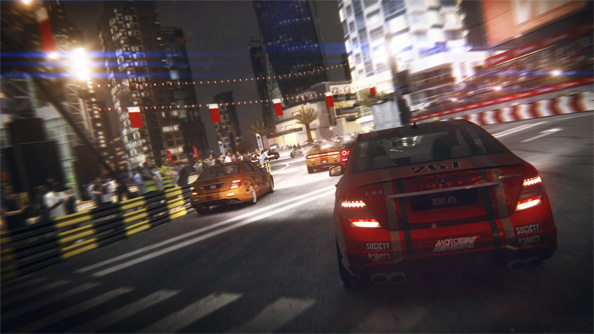
That said, getting familiar with tracks is made more difficult by the addition of dynamic junctions at certain points in certain races. Codemasters call them LiveRoutes, roads that open and shut at random to create new routes through an area, a bit like Outrun, with branching and forking paths that double back on themselves. It’s an odd sensation, racing several laps of a track but gaining no familiarity for the corners, and it’s not one that I’m absolutely certain enhances the multiplayer racing experience. The game’s Abu Dhabi track demonstrated the new feature with a devious hairpin that would only sometimes crop up after a breakneck, narrow tunnel section, as if magic pixies had come in and rearranged the barriers while you were busy racing on another part of the track.
Because the tracks are changing, you’re left without a map in these races. And without pace notes, it’s only the environment and barrier colouring that’s left to suggest (to the inexperienced racer at least) how severe the next corner will be. The environment tends to make a poor co-driver. Those unknown turns would seem to put an unfair advantage in the hands of anybody who’s raced the dynamic track enough to understand which magic corners go where, and how hard they should be turning the wheel. Tellingly, that Abu Dhabi hairpin destroyed the cars of every racer bar that of the developer playing with us. On the flipside the system certainly works well in AI races, where the morphing routes lend races an exciting frisson of the unexpected, demanding on the fifth and sixth laps the same cautious racing syle normally only seen on the first.
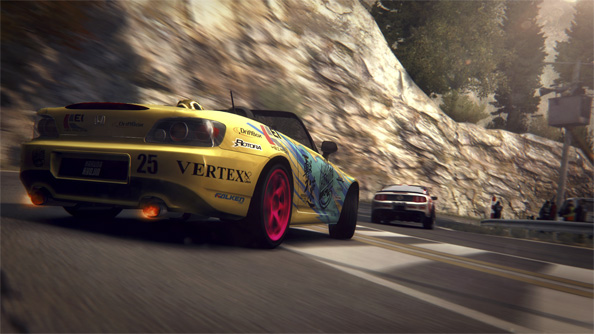
Drift events are even more technically demanding, requiring precision control over your vehicle along very short tracks. Corners have posts at their apex, and points are rewarded for how closely you can get your front bumper to them without leaving behind some paint. Endurance races test how long you can be bothered to play a videogame for, while elimination races sack the player in last place every time the pack rolls past a checkpoint. There’s variety in the game modes, and the game isn’t afraid to splay its content wide and offer it all up to you pretty much from the outset. In the preview build I was behind the wheel of a Bugatti Veyron within ten minutes of my first race. Codies promise the same openness will feature in the final game: Grid 2 isn’t interested in hiding its most exciting cars from the player.
Mutliplayer is a bigger deal in this sequel, with Codemasters plugging the game into their social racing network and giving it its own progression system separate from the single player game, as is du rigueur. The game will pull in a random rival matched to your skill level and pit you against them in a week of challenges, or you can form groups with friends and do all the fun things friends do when they play racing games together, beating each other’s times, doing the best skids, all that wonderful jazz. Up to 12 players can race, and there’s even a split-screen option for the PC version, which is novel enough. Car modifications and custom paint jobs are also on the cards, and there’s a neat (though hardly new) anti-griefing feature that turns asshole drivers into ghosts before they can ram into you head on.
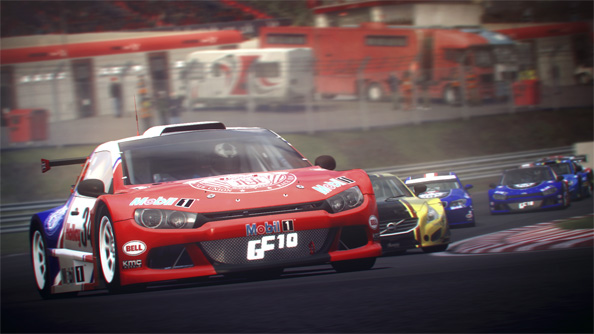
It’s better all round then, and it’s blindingly pretty to look at on PC, despite its slightly confused visual style. I’m still not sure what the single player narrative conceit is (it’s not that of a time-skipping Scott Bakula, rather it’s got something to do with being big on YouTube and earning subscribers by driving past them quickly in primary coloured cars), but it demands that everything be given a slight Kane & Lynch style video-compression edge when you crash. It’s all grit and dirty lenses, high contrast and chromatic abberations. No matter, it looks stunning and handles even better. This could be the next great racer. And as sequels go, Grid 2’s leap forwards is more than quantum.
WHAT A CALLBACK
I AM A WRITER HI MUM
